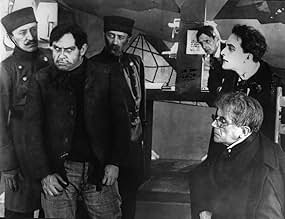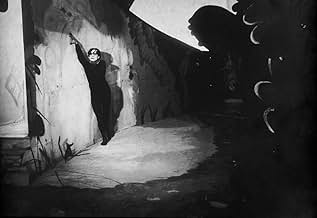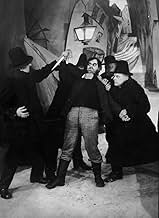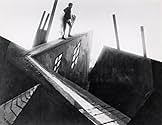NOTE IMDb
8,0/10
74 k
MA NOTE
L'hypnotiseur Dr Caligari utilise un somnambule, Cesare, pour commettre des meurtres.L'hypnotiseur Dr Caligari utilise un somnambule, Cesare, pour commettre des meurtres.L'hypnotiseur Dr Caligari utilise un somnambule, Cesare, pour commettre des meurtres.
- Réalisation
- Scénario
- Casting principal
- Récompenses
- 2 victoires et 1 nomination au total
Friedrich Feher
- Franzis
- (as Friedrich Fehér)
Hans Heinrich von Twardowski
- Alan
- (as Hans Heinz v. Twardowski)
Rudolf Lettinger
- Dr. Olsen
- (as Rudolph Lettinger)
Rudolf Klein-Rogge
- Ein Verbrecher
- (non crédité)
- …
Hans Lanser-Ludolff
- Ein Alter Mann
- (non crédité)
- …
Henri Peters-Arnolds
- Ein Junger Arzt
- (non crédité)
- …
Ludwig Rex
- Ein Mörder
- (non crédité)
- …
Elsa Wagner
- Die Wirtin
- (non crédité)
- …
Avis à la une
10wmackey
Dr. Caligari presents the viewer with a frightening vision of the world through the lens of German Expressionism.
I cannot recommend this film highly enough. It's truly fascinating. And, it really (really) is an art film, since it purposefully and strikingly exhibits the new art of the German inter-war milieu. So, be prepared for an other-worldly excursion into the "total work of art," or Gesamtkunstwerk, of this monumental and influential film.
This film is best seen at night, alone, and with the modern soundtrack which is available on the fully restored version. If the DVD you're watching does not have (a) choice of two soundtracks (traditional music and much-scarier modern track), (b) tinted inter-titles set in a surrealistic (actually expressionistic) font, and (3) is fairly high quality, then send it back and get the restored version. The quality and completeness of silent films are a major factor in experiencing the art form as it was meant to be experienced. The modern sound track in Dr. Caligari makes the film much more accessible for modern audiences (the eerie effects in the modern track heighten the feel of the film for the modern viewer) - try both tracks, you'll see.
It's surprising how frightening and impactful this film can be. You will have dreams about it, I promise. These between-the-wars German films are riddled with creepy foreshadowing for us in the present, who know what was about to happen in Germany.
Anyway, I think the film is best viewed with NO NOTICE. You don't really want to know the plot (the meaning of the end of the film can be interpreted in radically different ways - keep that in mind when it happens). Only one note - artistically the German Expressionist movement is worth reading about after you see the film - you'll notice the theme of "death and the maiden" woven into this artwork. Also, this film is the direct ancestor of films like "Nightmare Before Christmas" and a lot more - you'll recognize the Expressionist look in many presentations in television and film.
WARNING - I would NOT show this film to children. It's very subtly and psychologically undermining - you'll be thinking and freaking about this thing for months to come - such a thing shouldn't be experienced by children - it's an adult, art film (no, not that kind) made for adults.
I cannot recommend this film highly enough. It's truly fascinating. And, it really (really) is an art film, since it purposefully and strikingly exhibits the new art of the German inter-war milieu. So, be prepared for an other-worldly excursion into the "total work of art," or Gesamtkunstwerk, of this monumental and influential film.
This film is best seen at night, alone, and with the modern soundtrack which is available on the fully restored version. If the DVD you're watching does not have (a) choice of two soundtracks (traditional music and much-scarier modern track), (b) tinted inter-titles set in a surrealistic (actually expressionistic) font, and (3) is fairly high quality, then send it back and get the restored version. The quality and completeness of silent films are a major factor in experiencing the art form as it was meant to be experienced. The modern sound track in Dr. Caligari makes the film much more accessible for modern audiences (the eerie effects in the modern track heighten the feel of the film for the modern viewer) - try both tracks, you'll see.
It's surprising how frightening and impactful this film can be. You will have dreams about it, I promise. These between-the-wars German films are riddled with creepy foreshadowing for us in the present, who know what was about to happen in Germany.
Anyway, I think the film is best viewed with NO NOTICE. You don't really want to know the plot (the meaning of the end of the film can be interpreted in radically different ways - keep that in mind when it happens). Only one note - artistically the German Expressionist movement is worth reading about after you see the film - you'll notice the theme of "death and the maiden" woven into this artwork. Also, this film is the direct ancestor of films like "Nightmare Before Christmas" and a lot more - you'll recognize the Expressionist look in many presentations in television and film.
WARNING - I would NOT show this film to children. It's very subtly and psychologically undermining - you'll be thinking and freaking about this thing for months to come - such a thing shouldn't be experienced by children - it's an adult, art film (no, not that kind) made for adults.
10clurge-2
Like so many of the films from the silent era, The Cabinet of Dr. Caligari gets overlooked (if you can even find it!) for big budget duds, and runny romantic comedies. Directors of the period like Griffith, Lang, Eisenstien, and Caligari's Wiene, are never given the credit they deserve. And if credit is given, it is in small cultish circles in various pockets around the world.
The set design here is amazing, not a single right angle can be found in any one of the sets. This may not only apply to the disjointed and distorted characters in the film, but also the state of Germany at the time. After all, the film was made in the dark ages in Germany between WWI and WWII. This point is validated by Siegfried Kracauer, with his notion of how the main character of Dr. Caligari can be easily interpreted to Hitler, and vice versa. Both controlled subjects with a form of "brainwashing", both were upset with current forms of society and government, and both were masters of deception. In a period where Germans were looking for direction, and let's face it, authority as well, Dr. Caligari embodied it fully.
In the area of the players, all the names in the film turn out a literally "speechless" performance. Dagover, Krauß, and especially Veidt as Cesare (pronounced Chez-a-ray) are excellent in the use of gestures and motion to get their point across without using words. The camera, stationary as in most early features, uses the mise-en-scene effectively, letting us identify with characters such as Francis and Jane, and disjointing us from Caligari, and the Criminal.
The use of lines and stripes, not only in the sets but in small places like in the good doctor's hair and on his gloves, adds to the telling of the character. Colour tints of the B&W film also play a special part in bringing the whole film together. An amazing sequence where Caligari reveals his true madness, pits Caligari stumbling through the unequal streets of Germany while being haunted by textual ramblings written in the air. A marvelous achievement for it's time. And it adds so much.
The Cabinet Of Dr. Caligari has changed the way I look at horror films, and even films in general. I urge anyone reading this to pick up this film. The DVD offering is utterly fantastic with the restored print, an audio essay of the film, and production notes. Bypass the overblown "motion picture events of the year", and pick up Caligari, quite possible the greatest motion picture event in the history of motion pictures.
The set design here is amazing, not a single right angle can be found in any one of the sets. This may not only apply to the disjointed and distorted characters in the film, but also the state of Germany at the time. After all, the film was made in the dark ages in Germany between WWI and WWII. This point is validated by Siegfried Kracauer, with his notion of how the main character of Dr. Caligari can be easily interpreted to Hitler, and vice versa. Both controlled subjects with a form of "brainwashing", both were upset with current forms of society and government, and both were masters of deception. In a period where Germans were looking for direction, and let's face it, authority as well, Dr. Caligari embodied it fully.
In the area of the players, all the names in the film turn out a literally "speechless" performance. Dagover, Krauß, and especially Veidt as Cesare (pronounced Chez-a-ray) are excellent in the use of gestures and motion to get their point across without using words. The camera, stationary as in most early features, uses the mise-en-scene effectively, letting us identify with characters such as Francis and Jane, and disjointing us from Caligari, and the Criminal.
The use of lines and stripes, not only in the sets but in small places like in the good doctor's hair and on his gloves, adds to the telling of the character. Colour tints of the B&W film also play a special part in bringing the whole film together. An amazing sequence where Caligari reveals his true madness, pits Caligari stumbling through the unequal streets of Germany while being haunted by textual ramblings written in the air. A marvelous achievement for it's time. And it adds so much.
The Cabinet Of Dr. Caligari has changed the way I look at horror films, and even films in general. I urge anyone reading this to pick up this film. The DVD offering is utterly fantastic with the restored print, an audio essay of the film, and production notes. Bypass the overblown "motion picture events of the year", and pick up Caligari, quite possible the greatest motion picture event in the history of motion pictures.
This movie was shot between 1919 and 1920, a few decades since the motion picture camera was invented, and the Lumière brothers were in the middle of their experiments with it. At the time, cinema was being considered as a new way of making art, and yo make art you had to marry with a serie of ideas: ideology, aesthetics, cosmogony, etc. In these terms, this movie belongs to the German expressionism, which is reflected in the entire setup: from characters make up to the background of the set.
Having an average murder-mystery plot, the movie can be defined as a painting with some action occurring in it. The whole scenario was displayed following the same criteria as in expressionist painting: all diagonal and curve lines, evading the straightness and the cardinal orientation of things, wicked perspectives and proportions. Even the more minimum detail was carefully considered to fulfill the aesthetics needs. The result couldn't have been better, considering that the only visual trick they could do was to shrink/enlarge the camera's diafragma. Think that this was before the concept of travelling was even developed.
Concerning the plot, yet it's true that it isn't really the great thing and that many people now a days find it boring, I got to enjoy it, further than its aesthetical function (I even got to laugh in a couple of scenes), and I highly recommend it, as a good old piece of art from which many of today's film makers may take some good lessons on how to approach movies. I'm sure that if they got understand that, then there would be much lesser crappy movies than there are now a days.
Having an average murder-mystery plot, the movie can be defined as a painting with some action occurring in it. The whole scenario was displayed following the same criteria as in expressionist painting: all diagonal and curve lines, evading the straightness and the cardinal orientation of things, wicked perspectives and proportions. Even the more minimum detail was carefully considered to fulfill the aesthetics needs. The result couldn't have been better, considering that the only visual trick they could do was to shrink/enlarge the camera's diafragma. Think that this was before the concept of travelling was even developed.
Concerning the plot, yet it's true that it isn't really the great thing and that many people now a days find it boring, I got to enjoy it, further than its aesthetical function (I even got to laugh in a couple of scenes), and I highly recommend it, as a good old piece of art from which many of today's film makers may take some good lessons on how to approach movies. I'm sure that if they got understand that, then there would be much lesser crappy movies than there are now a days.
It struck me last night that I've never seen a serious silent film. Everyone's seen a silent comedy: Charlie Chaplin, Buster Keaton, the Keystone Cops... They've all been immortalized in the minds of every film viewer, and I enjoy them as much as anyone. But it seems a strange and almost disrespectful lack to never have seen anything but comedy; so many silent films were created, and the only ones I've seen starred waddling tramps.
It was partially for that reason that I rented this movie. I had read about it on a film review site (the name of which escapes my memory) and decided it was worth the half-hour drive to the video store. The basic premise is that of a man relating a story that happened to him and his friends - their unnerving discovery of a crazed mountebank, Dr. Caligari, and his prophetic sleepwalker. It follows a series of murders and growing madness, keeping you in constant suspense and confusion until the very last scene.
There's a period of adjustment when watching it - unfortunately necessary for a modern audience. The titles seem too slow. The camera seems to hold on scenes too long. The makeup on the actors' faces seem ghostly and horrible - even on the hero.
But before long, the movie has you in its grip. You spend time staring at the architecture - buildings, doors, and windows that would have been funny in a Dr. Seuss book. In the film, they make you uneasy. The whole atmosphere is of a world gone wrong; like a dream worthy of Salvador Dalí. Nothing is square or straight. The buildings loom in on you; windows sweep upward, slanted or curved; doors are obscenely angled holes beckoning you to enter and be trapped inside.
Throughout, the story defies expectations. Small plot twists confuse and mislead you until the final surprise, completely tearing down everything you thought the movie was about. Strange shadows and shots from inside alleys paint the film's world as something terrible, never allowing you a normal look at the village, never allowing you to enjoy the quaintness of it. Through it all, the grinning, hunched figure of Dr. Caligari hangs in your mind, pushing out rational thought.
The movie is well worth your time; there's a certain pleasure in trying to capture the feeling of terror an early audience, unaccustomed to the visual effects we see every day, would have had the first time they saw this movie. It's an intellectual terror in the grand old style, giving you the same thrill you get from reading Frankenstein or Dr. Jekyll and Mr. Hyde. At the risk of sounding cliché: two thumbs up!
It was partially for that reason that I rented this movie. I had read about it on a film review site (the name of which escapes my memory) and decided it was worth the half-hour drive to the video store. The basic premise is that of a man relating a story that happened to him and his friends - their unnerving discovery of a crazed mountebank, Dr. Caligari, and his prophetic sleepwalker. It follows a series of murders and growing madness, keeping you in constant suspense and confusion until the very last scene.
There's a period of adjustment when watching it - unfortunately necessary for a modern audience. The titles seem too slow. The camera seems to hold on scenes too long. The makeup on the actors' faces seem ghostly and horrible - even on the hero.
But before long, the movie has you in its grip. You spend time staring at the architecture - buildings, doors, and windows that would have been funny in a Dr. Seuss book. In the film, they make you uneasy. The whole atmosphere is of a world gone wrong; like a dream worthy of Salvador Dalí. Nothing is square or straight. The buildings loom in on you; windows sweep upward, slanted or curved; doors are obscenely angled holes beckoning you to enter and be trapped inside.
Throughout, the story defies expectations. Small plot twists confuse and mislead you until the final surprise, completely tearing down everything you thought the movie was about. Strange shadows and shots from inside alleys paint the film's world as something terrible, never allowing you a normal look at the village, never allowing you to enjoy the quaintness of it. Through it all, the grinning, hunched figure of Dr. Caligari hangs in your mind, pushing out rational thought.
The movie is well worth your time; there's a certain pleasure in trying to capture the feeling of terror an early audience, unaccustomed to the visual effects we see every day, would have had the first time they saw this movie. It's an intellectual terror in the grand old style, giving you the same thrill you get from reading Frankenstein or Dr. Jekyll and Mr. Hyde. At the risk of sounding cliché: two thumbs up!
10Gafke
Made in 1919, "The Cabinet of Doctor Caligari" was literally years ahead of its time and remains a triumphant accomplishment in the genre of German Expressionism. Remembered mainly for its stunning sets, which featured crooked buildings and twisted landscapes, "Cabinet" also boasts one of the first attempts at a twist ending, something quite new and shocking for its time.
Told mainly from the point of view of Francis, a young man who lives in the small village of Holstenwall, Germany, "Cabinet" tells the tale of murder and madness which seems to accompany the arrival of a carnival. Francis and his best friend Alan go to the carnival and are presented with the sideshow attraction Cesare the Somnambulist, a gaunt and hideous young man who spends his life sleeping in a coffin-like cabinet and seems able to predict the future when awake. Cesare (played by a young Conrad Veidt, who later went on to play the evil Nazi general in Casablanca) informs Alan that he will soon die, and indeed, Alan is found murdered the next morning. Suspicion turns to the eerie somnambulist and his strange keeper, a man called Caligari. As Francis desperately tries to solve the mystery and find his friends killer, it seems that the beautiful young Jane, beloved by both Alan and Francis, has been targeted as the next victim.
This is a genuinely creepy film which delves deep into the mysteries of the abnormal mind...an uncomfortable journey to say the least. Everyone is suspect and, in the end, we must ask ourselves: "who is really the mad one here?"
Subtle and ingenious, we see the world the way an insane person might see it; warped and confused, a nightmarish terrain where nothing makes sense and balance is not to be found.
The impact of this film is still being felt and seen today, and for good reason. It is a shocking, disturbing masterpiece. I cannot recommend it highly enough.
Told mainly from the point of view of Francis, a young man who lives in the small village of Holstenwall, Germany, "Cabinet" tells the tale of murder and madness which seems to accompany the arrival of a carnival. Francis and his best friend Alan go to the carnival and are presented with the sideshow attraction Cesare the Somnambulist, a gaunt and hideous young man who spends his life sleeping in a coffin-like cabinet and seems able to predict the future when awake. Cesare (played by a young Conrad Veidt, who later went on to play the evil Nazi general in Casablanca) informs Alan that he will soon die, and indeed, Alan is found murdered the next morning. Suspicion turns to the eerie somnambulist and his strange keeper, a man called Caligari. As Francis desperately tries to solve the mystery and find his friends killer, it seems that the beautiful young Jane, beloved by both Alan and Francis, has been targeted as the next victim.
This is a genuinely creepy film which delves deep into the mysteries of the abnormal mind...an uncomfortable journey to say the least. Everyone is suspect and, in the end, we must ask ourselves: "who is really the mad one here?"
Subtle and ingenious, we see the world the way an insane person might see it; warped and confused, a nightmarish terrain where nothing makes sense and balance is not to be found.
The impact of this film is still being felt and seen today, and for good reason. It is a shocking, disturbing masterpiece. I cannot recommend it highly enough.
Le saviez-vous
- AnecdotesWriter Hans Janowitz claims to have gotten the idea for the film when he was at a carnival one day. He saw a strange man lurking in the shadows. The next day he heard that a girl was brutally murdered there. He went to the funeral and saw the same man lurking around. He had no proof that the strange man was the murderer, but he fleshed the whole idea out into his film.
- GaffesIn the wide shot, the sign at the asylum reads "Insane Asylum," in English. In the close-up, the sign is written in German (Kino Blu-ray Disc version, may not be present in all editions of the film).
- Versions alternativesUSA laserdisc reissue restores the original hand-drawn title cards that have been missing from every known print of the film since 1923. When first released on video in the United States, film was in black-and-white, and played back many scenes at double speed and featured different music. Although no scenes were cut out, the running time was reduced to only 51 minutes. The restored version restores the colour-tinting, restores the original title cards, and plays the film back at regular speed, returning the film to its original 69-minute running time.
- ConnexionsEdited into People Who Die Mysteriously in Their Sleep (2004)
Meilleurs choix
Connectez-vous pour évaluer et suivre la liste de favoris afin de recevoir des recommandations personnalisées
Détails
- Date de sortie
- Pays d’origine
- Langue
- Aussi connu sous le nom de
- El gabinete del Dr. Caligari
- Lieux de tournage
- Société de production
- Voir plus de crédits d'entreprise sur IMDbPro
Box-office
- Budget
- 18 000 $US (estimé)
- Montant brut aux États-Unis et au Canada
- 8 811 $US
- Montant brut mondial
- 9 297 $US
- Durée
- 1h 18min(78 min)
- Mixage
- Rapport de forme
- 1.37 : 1
Contribuer à cette page
Suggérer une modification ou ajouter du contenu manquant





























